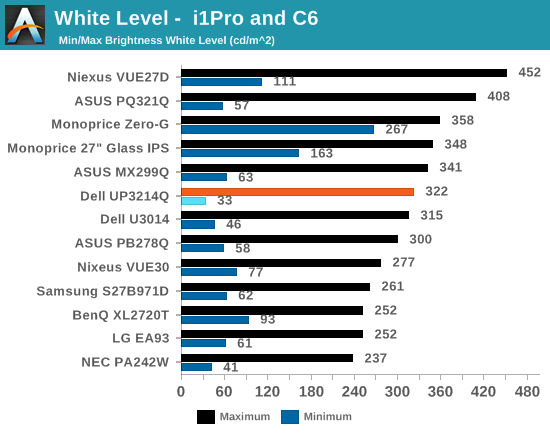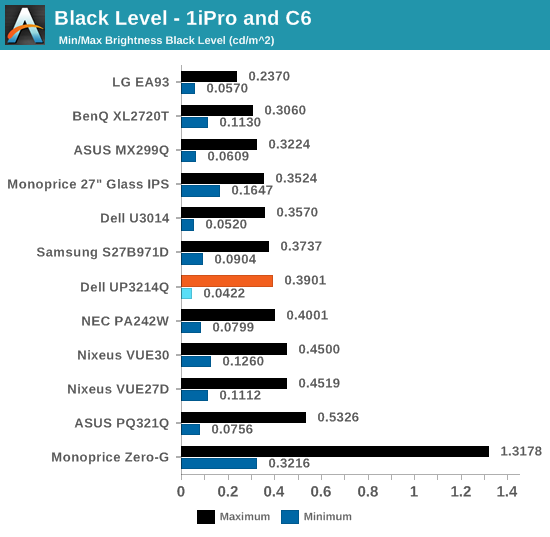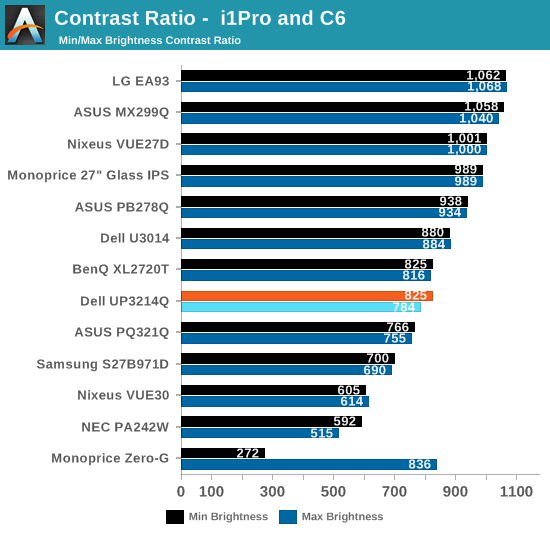Dell UP3214Q Review
by Chris Heinonen on April 1, 2014 12:00 AM ESTWith the backlight set to maximum in sRGB mode I measure 322 cd/m2 of brightness with a pure white screen on the UP3214Q. Setting the backlight to minimum results in a reading of 33 cd/m2. I could possibly use a different color preset to get a higher reading, but that usually means tinted whites and a loss of dynamic range, so I prefer to stick to the maximum value you would want in a real world setting.

Using the same test setup for black levels, the Dell emits 0.3901 cd/m2 of light with the backlight at maximum and 0.0422 cd/m2 with the backlight at minimum.

Combined, we get contrast ratios around 800:1. In comparison to the only other UltraHD display reviewed to this point, the ASUS PQ321Q, the Dell has a slightly higher contrast ratio but a slightly lower maximum light output. I believe the combination on the Dell is better for most people as going past 300 cd/m2 produces an image most people find too bright but everyone can utilize a higher contrast ratio. That said, the contrast ratio difference isn’t huge, as you can see.

UltraHD displays are still lagging behind QHD displays when it comes to contrast ratio, as those are approaching 1,100:1 now. It isn’t bad, but it’s also an area that hopefully can improve over the next year or two as better panels become available.










84 Comments
View All Comments
willis936 - Tuesday, April 1, 2014 - link
I'm not sure this is right. Companies usually are making and testing IP while a standard is in the works. In some cases they're out before the standard is done.cheinonen - Tuesday, April 1, 2014 - link
This is correct. There is currently no full HDMI 2.0 silicon out there that I'm aware of, and since the Dell started shipping last fall it certainly didn't have access to it then. There are currently devices shipping that claim "HDMI 2.0" support in the AV world, but that isn't full HDMI 2.0. It is support for 4:2:0 chroma subsampling, which is part of the HDMI 2.0 spec, and enabled UltraHD resolution at 60 Hz. Since computers don't use chroma subsampling, this isn't relevant and there is no HDMI 2.0 silicon right now.Penti - Tuesday, April 1, 2014 - link
Not even Maxwell can output it, so what sources are you suppose to use?BMNify - Tuesday, April 1, 2014 - link
where you get that idea from , its false you need a GeForce 600 "Kepler" graphics card or newer to drive a display up to 4096 x 2160.hell, even the ChromeOS guys have merged this linux UHD patch in to their tree now...so intel Haswell/Iris Graphics work at "UHD-1" 3840x2160P if you are not gaming http://lists.x.org/archives/xorg-devel/2014-Januar...
cheinonen - Tuesday, April 1, 2014 - link
You can do that resolution at 24 Hz, or 3840x2160 at 30 Hz, but you can't do it at 60 Hz without MST right now. HDMI 2.0 allows it at 60 Hz but that isn't available yet on a product.Penti - Tuesday, April 1, 2014 - link
I was speaking about 600MHz HDMI not ~300MHz. 300MHz HDMI has been around since GCN 1.0 and Kepler. It's also available in Haswell, works fine in Windows, OS X or GNU/Linux at that res, but that limits it's to 30Hz for 3840x2160. That's not HDMI 2.0 specs. You can't use anything else than DisplayPort for 60Hz 4k/UHD. DisplayPort-receivers only do that on MST too. You need two 300MHz HDMI-ports to do UHD @ 60Hz. So gaming in UHD with HDMI is out regardless of gpu/source.Maxwell doesn't do H.265/HEVC for that matter either. You only need ~300MHz HDMI 1.4 to do 4096x2160 @ 24Hz. Not HDMI 2.0, that can do it @ 60Hz.
zanon - Tuesday, April 1, 2014 - link
As far as things that still aren't there, I'd throw in color space (both gamut and bit depth) as well. Official UHDTV (see Rec. 2020), beyond the resolution standards bumping to 4K or 8K, also at last features a significantly larger color space and also the depth necessary to go with it (either 10-bit or 12-bit). That's another marquee feature of HDMI 2.0, 12-bit 4:2:2 4K@60fps. Without the increase depth a wider gamut isn't a straight upgrade since the delta between colors increases too, 8-bit AdobeRGB say isn't a clear superset of 8-bit sRGB. It's exciting that as well as HiDPI we'll finally see an industry wide shift to a color space that will be a strict improvement and is large enough to basically be "done" as far as human vision.There's still a lot more pieces needed on the PC side though, including both hardware (video cards, interconnect) and OS/applications. High DPI is slowly improving, but even Apple has slipped a bit in terms of color management and support. That said, given the economies of scale that'll come with the general UHDTV push the market pressure should be there at least.
peterfares - Tuesday, April 1, 2014 - link
Did you test it on a Windows computer other than the one you pictured? Because that one is 8.0, not 8.1 which added multi-DPI support.datobin1 - Tuesday, April 1, 2014 - link
Correct, 8.0 has static scaling across all displays. 8.1 introduced different scaling for each display.This works very well for surface pros that are docked. It will scale the surface pro display at 150% and the extra monitors at 100%. If you move a window between the displays the screen with the majority of the window will decide the scaling for that window. As you pull it from one screen to the next you will see the window change its scaling factor.
cheinonen - Tuesday, April 1, 2014 - link
Yes, I tested with both Windows 8.0 and 8.1. I just happened to have rebooted into Windows 8.0 when I took the photos but I tested both.